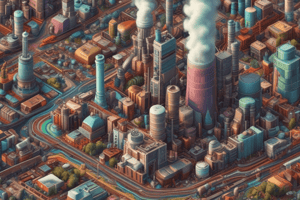Podcast
Questions and Answers
What is the main function of surfactants/detergents in rivers and lakes?
What is the main function of surfactants/detergents in rivers and lakes?
- Act as pesticides
- Decrease solubility of organic compounds
- Act as insulators
- Increase solubility of organic compounds (correct)
Which of these is true about PCBs according to the text?
Which of these is true about PCBs according to the text?
- They are used as pesticides
- They are non-toxic substances
- They have low distribution coefficients
- They can stay in the environment for more than 100 years (correct)
What is the significance of the left and right in the nomenclature of PCBs?
What is the significance of the left and right in the nomenclature of PCBs?
- Both sides represent the year of synthesis
- Prime side determines toxicity level
- Right side indicates the number of carbons in the compound
- Left side indicates the percent chlorine by weight (correct)
What causes the ozone hole according to the text?
What causes the ozone hole according to the text?
Which substance among the mentioned '12 dirties' can cause thinning of the ozone layer?
Which substance among the mentioned '12 dirties' can cause thinning of the ozone layer?
What type of products are formed from burning chlorinated products according to the text?
What type of products are formed from burning chlorinated products according to the text?
What is a natural source of Polychlorinated Aromatic Hydrocarbons (PAHs)?
What is a natural source of Polychlorinated Aromatic Hydrocarbons (PAHs)?
Which type of dyes require mordants for application and suffer from low color fastness?
Which type of dyes require mordants for application and suffer from low color fastness?
What causes the cancer-inducing effects of tobacco smoking according to the text?
What causes the cancer-inducing effects of tobacco smoking according to the text?
Which type of colorants are commonly used in staining but have poor resistance to light and chemical bleaching?
Which type of colorants are commonly used in staining but have poor resistance to light and chemical bleaching?
How can Methyl orange be synthesized according to the text?
How can Methyl orange be synthesized according to the text?
What is a common characteristic of Polychlorinated Biphenyls (PCBs), Dioxins, and Dibenzofurans?
What is a common characteristic of Polychlorinated Biphenyls (PCBs), Dioxins, and Dibenzofurans?
Which of the following is a property of polycyclic aromatic hydrocarbons (PAHs)?
Which of the following is a property of polycyclic aromatic hydrocarbons (PAHs)?
What is the purpose of using anthracene in wood?
What is the purpose of using anthracene in wood?
What is the main reason for the cancer-inducing effects of tobacco smoking?
What is the main reason for the cancer-inducing effects of tobacco smoking?
Which of the following is a natural dye that requires no pretreatment?
Which of the following is a natural dye that requires no pretreatment?
What is the main advantage of synthetic dyes over natural dyes?
What is the main advantage of synthetic dyes over natural dyes?
What is the purpose of using a mordant in dyeing?
What is the purpose of using a mordant in dyeing?
What is a common use of PCBs?
What is a common use of PCBs?
Which substance is considered the most toxic dioxin?
Which substance is considered the most toxic dioxin?
How do PCBs enter the body?
How do PCBs enter the body?
What do the first two digits in the nomenclature of PCBs represent?
What do the first two digits in the nomenclature of PCBs represent?
Which process is a source of environmental contamination of Dioxins?
Which process is a source of environmental contamination of Dioxins?
What is the main source of contamination by PCBs?
What is the main source of contamination by PCBs?
Which structural feature characterizes the MC Type PCBs?
Which structural feature characterizes the MC Type PCBs?
What characteristic makes PCBs resistant to oxidation?
What characteristic makes PCBs resistant to oxidation?
How are Dioxins accidentally synthesized?
How are Dioxins accidentally synthesized?
Which category does not represent a usage category of PCBs?
Which category does not represent a usage category of PCBs?
What is the most toxic dioxin among the mentioned substances?
What is the most toxic dioxin among the mentioned substances?
Which substance is commonly used as an insulator or lubricant?
Which substance is commonly used as an insulator or lubricant?
What category did 90% of PCBs fall into in the US in 1971?
What category did 90% of PCBs fall into in the US in 1971?
What is the natural source of Polyaromatic Hydrocarbons (PAHs)?
What is the natural source of Polyaromatic Hydrocarbons (PAHs)?
Which mechanism of action does 2,3,7,8-TCDD use to cause toxicity?
Which mechanism of action does 2,3,7,8-TCDD use to cause toxicity?
Where do dioxins and furans accumulate in the body?
Where do dioxins and furans accumulate in the body?
What is the main target organ affected by dioxins?
What is the main target organ affected by dioxins?
Which substance is NOT among the identified 'dirties' under the Stockholm Convention and Montreal Protocol?
Which substance is NOT among the identified 'dirties' under the Stockholm Convention and Montreal Protocol?
Which substances are most likely to cause skin cancer due to thinning of the ozone layer?
Which substances are most likely to cause skin cancer due to thinning of the ozone layer?
What property makes PCB congeners with chlorine in non-ortho positions more toxic?
What property makes PCB congeners with chlorine in non-ortho positions more toxic?
What is the main reason for using Anthracene in wood?
What is the main reason for using Anthracene in wood?
What are the properties of Polycyclic Aromatic Hydrocarbons (PAHs) with respect to water?
What are the properties of Polycyclic Aromatic Hydrocarbons (PAHs) with respect to water?
What is the main reason behind the cancer-inducing effects of tobacco smoking according to the text?
What is the main reason behind the cancer-inducing effects of tobacco smoking according to the text?
How are Dyes different from Pigments in terms of solubility?
How are Dyes different from Pigments in terms of solubility?
Which classification of Dyes is based on the interaction of organic molecules like aniline and benzene?
Which classification of Dyes is based on the interaction of organic molecules like aniline and benzene?
Why are Triphenylmethane Dyes used without consideration of light fastness?
Why are Triphenylmethane Dyes used without consideration of light fastness?
What is the main source of environmental contamination of PCBs?
What is the main source of environmental contamination of PCBs?
What is the primary reason for the resistance of PCBs to oxidation?
What is the primary reason for the resistance of PCBs to oxidation?
Which of the following is a property of PCBs that contributes to their higher solubility in fatty tissue?
Which of the following is a property of PCBs that contributes to their higher solubility in fatty tissue?
Which of the following is a source of dioxins?
Which of the following is a source of dioxins?
What is the most toxic dioxin compound mentioned in the text?
What is the most toxic dioxin compound mentioned in the text?
Which of the following is a chronic effect of dioxin exposure?
Which of the following is a chronic effect of dioxin exposure?
What is the primary target organ for the toxic effects of 2,3,7,8-TCDD?
What is the primary target organ for the toxic effects of 2,3,7,8-TCDD?
Which of the following is a natural source of polyaromatic hydrocarbons (PAHs)?
Which of the following is a natural source of polyaromatic hydrocarbons (PAHs)?
What is the mechanism of mutation caused by the planar structure of certain PCB congeners?
What is the mechanism of mutation caused by the planar structure of certain PCB congeners?
Which of the following is a property of the 2,3,7,8-TCDD dioxin compound?
Which of the following is a property of the 2,3,7,8-TCDD dioxin compound?
Flashcards are hidden until you start studying
Study Notes
Organic Pollutants
- All organic substances are toxic
- Types of organic pollutants:
- Polychlorinated Biphenyls (PCBs)
- Dioxins and Dibenzofurans
- Polyaromatic Hydrocarbons (PAHs)
- Surfactants/Detergents
- Pesticides
Polychlorinated Biphenyls (PCBs)
- Commonly used as insulators or lubricants
- Sources of environmental contamination:
- Open burning or incomplete combustion of PCB-containing solid waste
- Vaporization of PCBs in open applications
- Accidental spills or leakages
- Disposal into sewage systems
- Food (main source of contamination)
- Nomenclature: 4-digit code, first two digits represent the number of carbons, and the last two digits represent the percentage of chlorine by mass
- Toxicity: acute and chronic effects, including chloracne, cancer, and biochemical changes
- Physiochemical properties:
- Low aqueous solubility
- Non-flammability
- Resistance to oxidation
- Resistance to hydrolysis
- Low electrical conductivity
- LogKOW ranges from 3.76 to 6.38
Dioxins
- Usually accidentally synthesized as byproducts
- Sources of environmental contamination:
- Chemical processes involving chlorine
- Combustion processes
- Biocompost and sludges
- Most toxic dioxin: 2,3,7,8-tetrachlorodibenzo[1,4]dioxin (TCDD)
- Physiochemical properties:
- Similar to PCBs
- LogKOW of 6.8
- Toxicity: acute and chronic effects, including chloracne, cancer, and immunotoxicity
- Mechanism of toxic action: binds to aryl hydrocarbon receptor (AhR)
Polyaromatic Hydrocarbons (PAHs)
- Natural sources: volcanic eruptions, natural petroleum, fires
- Anthropogenic sources: petroleum spills, wood burning, incinerations, cigarette smoke, coking plants
- Common PAHs: anthracene, benzo(a)pyrene, naphthalene
- Uses: pigments (water insoluble) and dyes (water soluble)
- Toxicity: immunosuppressant, carcinogenic, and mutagenic
- Physiochemical properties:
- Low aqueous solubility
- Non-flammability
- Resistance to oxidation
- Resistance to hydrolysis
- Low electrical conductivity
- LogKOW ranges from 3.36 to 6.04
Dyes
- Colored organic compounds
- Classification:
- Based on source: natural, synthetic
- Based on structure: azo, triphenylmethane, phthalein
- Uses: pigments (water insoluble) and dyes (water soluble)
- Examples: anthracene, benzo(a)pyrene, naphthalene
Studying That Suits You
Use AI to generate personalized quizzes and flashcards to suit your learning preferences.




